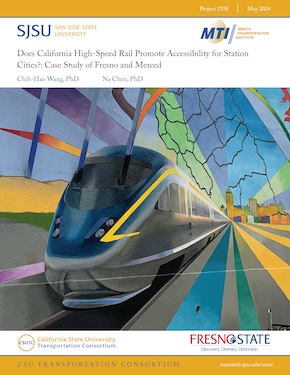- 408-924-7560
- mineta-institute@sjsu.edu
- Donate
Does California High-Speed Rail Promote Accessibility for Station Cities?: Case Study of Fresno and Merced
California High-Speed Rail (CHSR) will largely change transportation cost across the state after it starts operating. Past studies show that only Fresno and Merced among station cities in the Central Valley would attract more future activities with the CHSR. The establishment of active CHSR also implies a new daily living sphere for all the station cities, and, therefore, accessibility to work and residential amenities should be reviewed to inform planners of future land-use and transportation developments. A research framework has been developed better to understand the impact of CHSR on job and amenity accessibility by driving, transit, and walking in Fresno and Merced. The results show the opportunity cost of accessibility for using CHSR for a 25-minute ride from Fresno to Merced and vice versa. The study then compares the original accessibility reached in the home city within 45 minutes and the accessibility reached from the station in the other city within the remaining time after arriving at the station from home. A t-test was also used to examine whether the newly accessible jobs and amenities are significantly better with the CHSR. Finally, these results were mapped in contours showing equal accessibility before and after the start of CHSR operation for all blog groups in the two cities. This study not only adds to the literature on the impact of high-speed-rails on accessibility to jobs and amenities, but also contributes to the practice of public transit and car-sharing for better accessibility by providing planning information through the mapping of the results.
CHIH-HAO WANG, PHD
Dr. Chih-Hao Wang is an Associate Professor of the Department of Geography and City & Regional Planning at California State University, Fresno, where he has taught since 2014. He received his PhD (2013) and Master’s (2010) degrees in City and Regional Planning from The Ohio State University. Dr. Wang’s research focuses on environmental planning from the perspective of natural hazard mitigation. His research interests also include the application of spatial statistics to the analysis of spatial or social interactions in the earthquake process, as well as water management, transportation planning, and community development. His research has been published in journals in environmental planning, transportation, and geography.
NA CHEN, PHD
Dr. Na Chen is an Associate Professor in the School of Government at the Sun Yat-sen University in Guangzhou, China. She received her BA in Public Policy (2008) from Sun Yat-sen University, her MA in Community Planning and Public Administration (2011) from Auburn University, AL, and her PhD in City and Regional Planning (2016) from Ohio State University. She then worked as a postdoctoral scholar in the Department of Technology Management at the University of California, Santa Cruz. Her research interests include transportation planning, activity-based travel behavior modeling, accessibility, activity space, transportation equity, land-use modeling, spatial econometrics, and Geographic Information System applications for urban planning. Based on her expertise in her areas of interest, Dr. Chen has published many papers in peer-reviewed journals and presented at international conferences.
-
Contact Us
San José State University One Washington Square, San Jose, CA 95192 Phone: 408-924-7560 Email: mineta-institute@sjsu.edu






